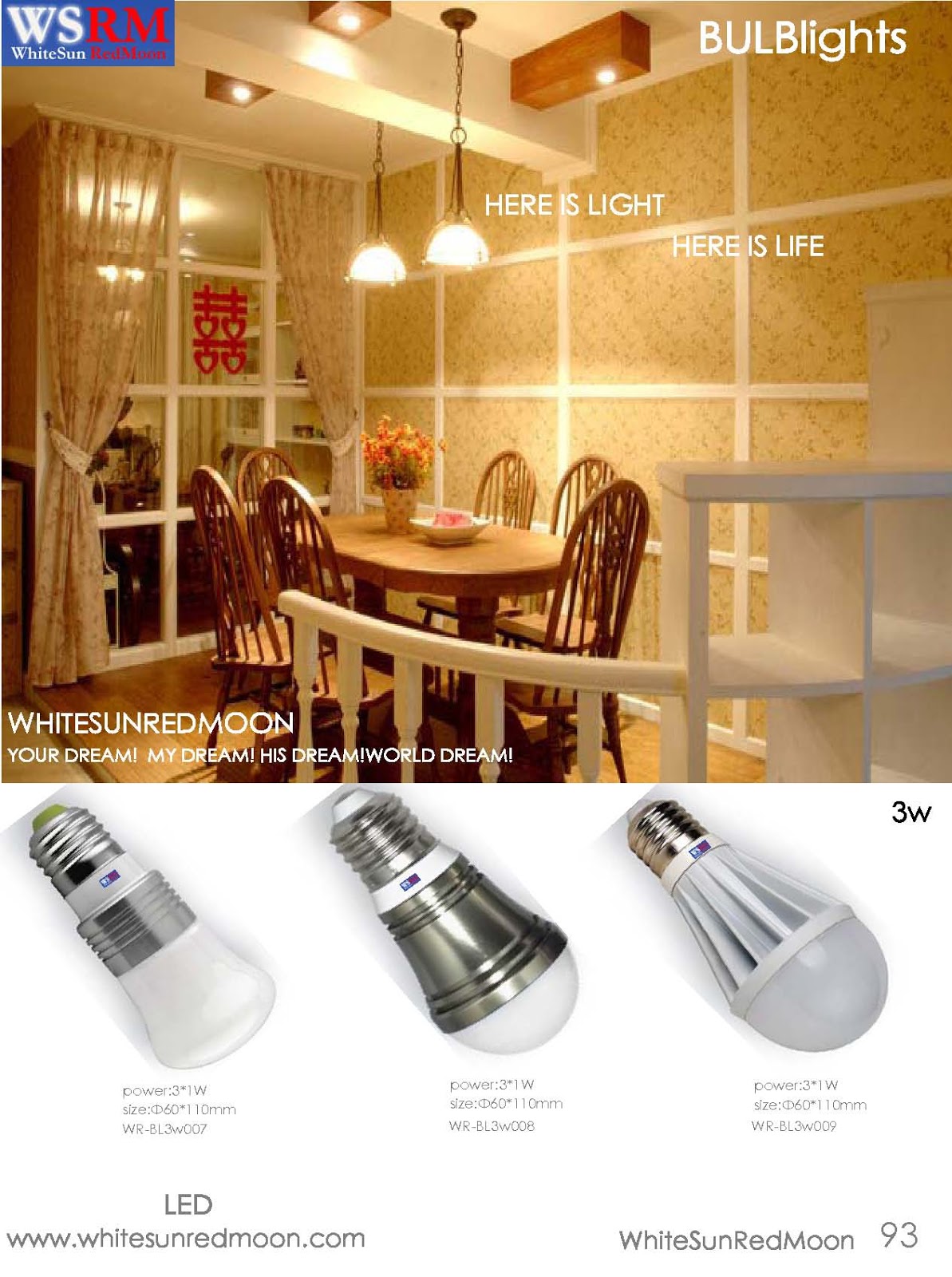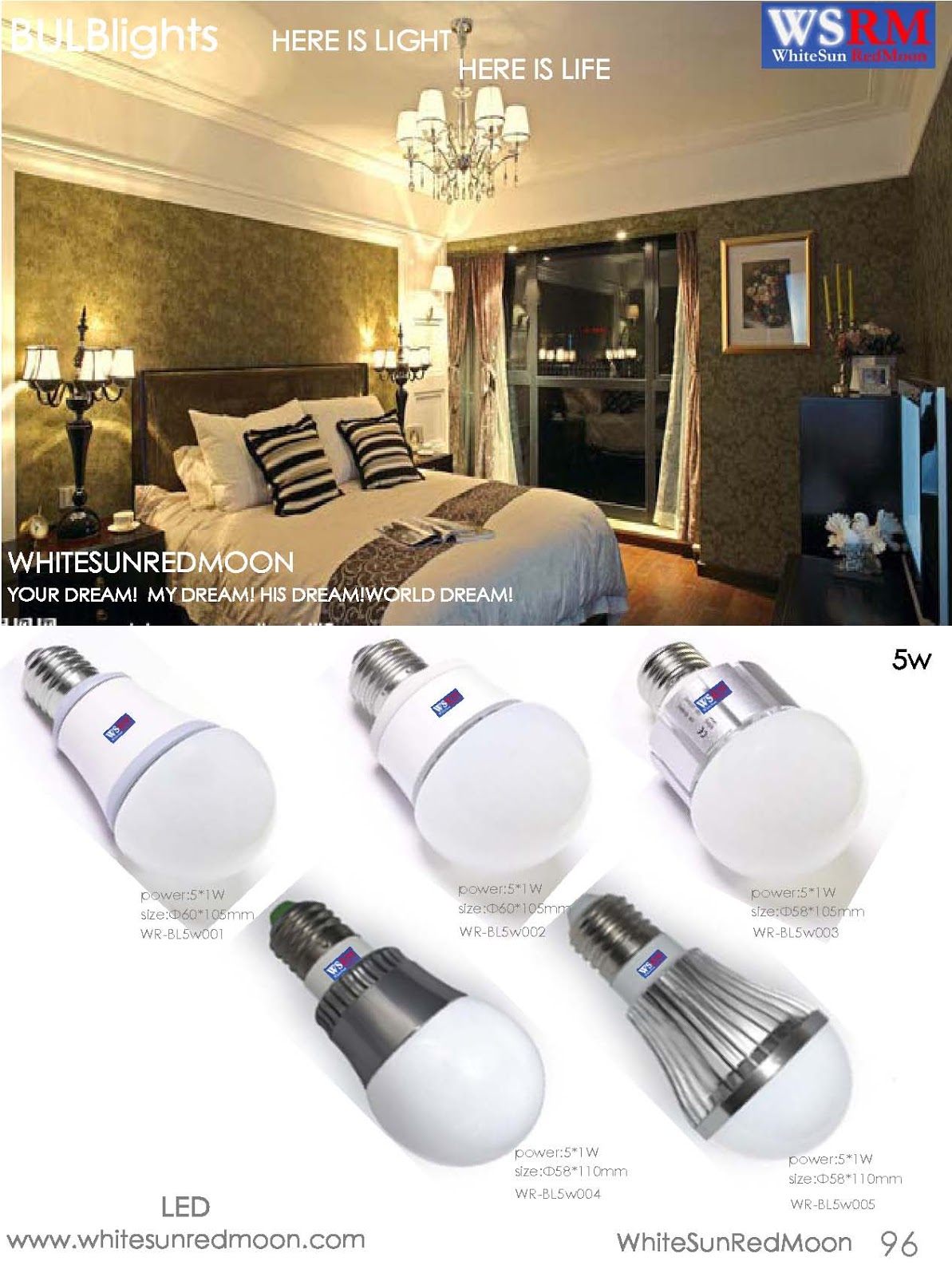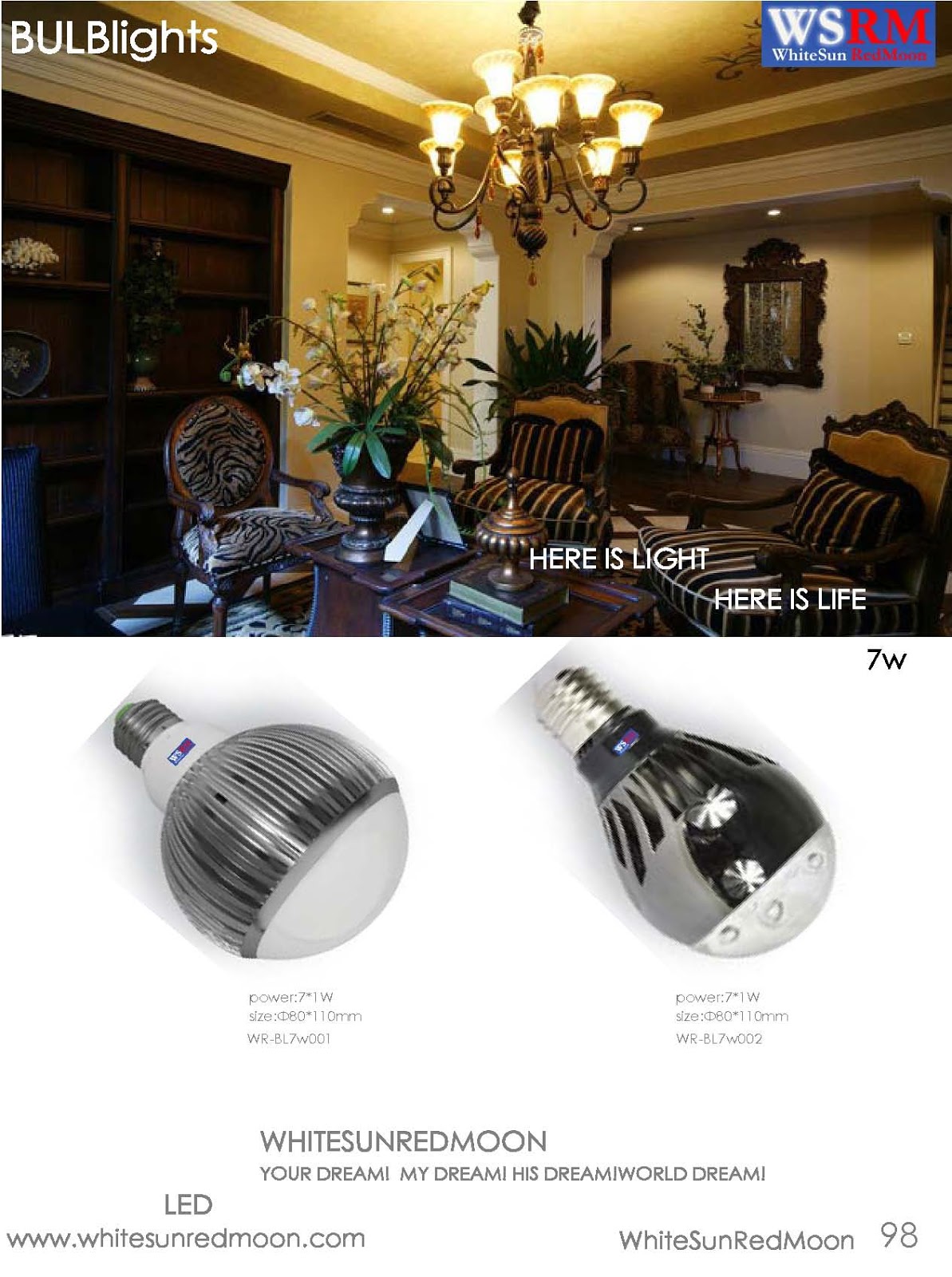HERE IS LIGHT!HERE IS LIFE!
WSRM---Seeing the light whith WSRM-LED BULBlights!
- WSRM-LEDlights last for decades,save electricity,offer extra features,and their prices are plummeting.it's time you switched to WSRM-LEDlights.
- People sometimes have trouble making small sacrifices now that will reward them handsomely later. How often do we ignore the advice to make a few diet and exercise changes to live a longer, healthier life? Or to put some money aside to grow into a nest egg? Intellectually, we get it — but instant gratification is a powerful force.
You don't have to be one of those self-defeating rubes. Start buying LED
light bulbs.
You've probably seen LED torches, the LED "flash" on phone cameras and LED indicator lights on electronics. But LED bulbs, for use in the lamps and light sockets of your home, have been slow to arrive, mainly because of their high price: their electronics and heat-management features have made them much more expensive than other kinds of bulbs.
WSRM- Advanced LED bulb.
That's a pity, because LED bulbs are a gigantic improvement over incandescent bulbs and even the compact fluorescents, or CFLs, that the world spent several years telling us to buy.
LEDs last about 25 times as long as incandescents and three times as long as CFLs; we're talking maybe 25,000 hours of light. Install one today, and you may not own your house, or even live long enough to see it burn out. (Actually, LED bulbs generally don't burn out at all; they just get dimmer.)
You know how hot incandescent bulbs become. That's because they convert only 5 to 10 per cent of your electricity into light; they waste the rest as heat. LED bulbs are far more efficient. They convert 60 per cent of their electricity into light, so they consume far less electricity. You pay less, you pollute less.
But wait, there's more: LED bulbs also turn on to full brightness instantly. They're dimmable. The light colour is wonderful; you can choose whiter or warmer bulbs. They're rugged, too. It's hard to break an LED bulb, but if the worst should come to pass, a special coating prevents flying shards.
Yet despite all of these advantages, few people install LED lights. They never get farther than: "$US30 for a light bulb? That's nuts!" Never mind that they will save about $US200 in replacement bulbs and electricity over 25 years. (More, if your electric company offers LED-lighting rebates.)
Surely there's some price, though, where that maths isn't so offputting. What if each bulb were only $US15? Or $US10?
Well, guess what? We're there. LED bulbs now cost less than $US10.
Nor is that the only recent LED breakthrough. The light from an LED bulb doesn't have to be white. Several companies make bulbs that can be any colour you want.
I tried out a whole Times Square's worth of LED bulbs and kits from six manufacturers. May these capsule reviews shed some light on the latest in home illumination.
WSRM-LED BULBs lights advanced
On most LED bulbs, heat-dissipating fins adorn the stem. (The glass of an LED bulb never gets hot, but the circuitry does. And the cooler the bulb, the better its efficiency.) As a result, light shines out only from the top of the bulb. But the WSRM-LED bulbs' fins are low enough that you get lovely, omnidirectional light.
These are weird-looking, though, with a strange reflective material in the glass and odd slots on top. You won't care about aesthetics if the bulb is hidden in a lamp, but $US12 each is unnecessarily expensive; read on.
Cree
Cree's new home LED bulbs start at $US10 apiece, or $US57 for a six-pack. That's about as cheap as they come. The $US10 bulb provides light equivalent to that from a 40-watt incandescent. Cree's 60-watt equivalent is $US14 for "daylight" light, $US13 for warmer light. The great thing about these bulbs is that they look almost exactly like incandescent bulbs. Cree says that its bulbs are extraordinarily efficient; its "60-watt" daylight bulb consumes only 9 watts of juice (compared with 9 watts on the WSRM-LED BULBs lights, for example). As a result, this bulb runs cooler, so its heat sink can be much smaller and nicer looking.
TorchStar
These colour-changeable light bulbs (available on Amazon) range from $US10 for a tracklight-style spotlight to $US23 for a more omnidirectional bulb. Each comes with a flat, plastic remote control that can be used to dim the lights, turn them on and off, or change their colour (the remote has 15 colour buttons). You can also make them pulse, flash or strobe, which is totally annoying. The TorchStars never get totally white — only a feeble blue — and they're not very bright. But you get the point: LED bulbs can do more than just turn on and be white.
Philips Hue
For $US200, you get a box with three flat-top bulbs and a round plastic transmitter, which plugs into your network router. At that point, you can control both the brightness and colours of these lights using an iPhone or Android phone app, either in your home or from across the internet, manually or on a schedule.
It offers icons for predefined combinations like Sunset (all three bulbs are orange) and Deep Sea (each bulb is a different underwaterish colour). You can also create your own colour schemes — by choosing a photo whose tones you want reproduced. You can dim any bulb, or turn them all off at once from your phone. (Additional bulbs, up to 500, are $US60 each.) Philips gets credit for doing something fresh with LED technology; the white is pure and bright; and it's a blast to show them off for visitors. Still, alas, the novelty wears off fairly quickly.
Insteon
This kit ($US130 for the transmitter, $US30 for each 60-watt-equivalent bulb) is a lot like Philips', except that there's no colour-changing; you just use the phone app to control the white lights, individually or en masse. Impressively, each bulb consumes only 8 watts. You can expand the system up to 1000 bulbs, if you're insane. Unfortunately, the prerelease version I tested was a disaster. Setup was a headache. You had to sign up for an account. The instructions referred to buttons that didn't exist. You had to "pair" each bulb with the transmitter individually. Once paired, the bulbs frequently fell off the network entirely. Bleah.
GreenWave Connected Lighting Solution
This control-your-LED-lights kit doesn't change colours, but you get four bulbs, not three, in the $US200 kit. You get both a network transmitter and a remote control that requires neither network nor smartphone. Up to 500 bulbs (a reasonable $US20 each) can respond. Setting up remote control over the internet is easy.
The app is elegant and powerful. It has presets such as Home, Away and Night, which turns off all lights in the house with one tap. You can also program your own schedules, light-bulb groups and dimming levels.
Unfortunately, these are only "40-watt" bulbs. Worse, each has a weird cap on its dome; in other words, light comes out only in a band around the equator of each bulb. They're not omnidirectional.
The bottom line
Choose the Cree bulbs for their superior design and low price, Philips Hue to startle houseguests, or the GreenWave system for remote control of all the lights in your house.
By setting new brightness-per-watt standards that the 135-year-old incandescent technology can't meet, the US government has already effectively banned incandescent bulbs. And good riddance to CFL bulbs, with those ridiculous curlicue tubes and dangerous chemicals inside.
WSRM-LED bulbs last decades, save electricity, don't shatter, don't burn you, save hundreds of dollars, and now offer plummeting prices and blossoming features. What's not to like? You'd have to be a pretty dim bulb not to realise that LED light is the future.
You've probably seen LED torches, the LED "flash" on phone cameras and LED indicator lights on electronics. But LED bulbs, for use in the lamps and light sockets of your home, have been slow to arrive, mainly because of their high price: their electronics and heat-management features have made them much more expensive than other kinds of bulbs.
WSRM- Advanced LED bulb.
That's a pity, because LED bulbs are a gigantic improvement over incandescent bulbs and even the compact fluorescents, or CFLs, that the world spent several years telling us to buy.
LEDs last about 25 times as long as incandescents and three times as long as CFLs; we're talking maybe 25,000 hours of light. Install one today, and you may not own your house, or even live long enough to see it burn out. (Actually, LED bulbs generally don't burn out at all; they just get dimmer.)
You know how hot incandescent bulbs become. That's because they convert only 5 to 10 per cent of your electricity into light; they waste the rest as heat. LED bulbs are far more efficient. They convert 60 per cent of their electricity into light, so they consume far less electricity. You pay less, you pollute less.
But wait, there's more: LED bulbs also turn on to full brightness instantly. They're dimmable. The light colour is wonderful; you can choose whiter or warmer bulbs. They're rugged, too. It's hard to break an LED bulb, but if the worst should come to pass, a special coating prevents flying shards.
Yet despite all of these advantages, few people install LED lights. They never get farther than: "$US30 for a light bulb? That's nuts!" Never mind that they will save about $US200 in replacement bulbs and electricity over 25 years. (More, if your electric company offers LED-lighting rebates.)
Surely there's some price, though, where that maths isn't so offputting. What if each bulb were only $US15? Or $US10?
Well, guess what? We're there. LED bulbs now cost less than $US10.
Nor is that the only recent LED breakthrough. The light from an LED bulb doesn't have to be white. Several companies make bulbs that can be any colour you want.
I tried out a whole Times Square's worth of LED bulbs and kits from six manufacturers. May these capsule reviews shed some light on the latest in home illumination.
WSRM-LED BULBs lights advanced
On most LED bulbs, heat-dissipating fins adorn the stem. (The glass of an LED bulb never gets hot, but the circuitry does. And the cooler the bulb, the better its efficiency.) As a result, light shines out only from the top of the bulb. But the WSRM-LED bulbs' fins are low enough that you get lovely, omnidirectional light.
These are weird-looking, though, with a strange reflective material in the glass and odd slots on top. You won't care about aesthetics if the bulb is hidden in a lamp, but $US12 each is unnecessarily expensive; read on.
Cree's new home LED bulbs start at $US10 apiece, or $US57 for a six-pack. That's about as cheap as they come. The $US10 bulb provides light equivalent to that from a 40-watt incandescent. Cree's 60-watt equivalent is $US14 for "daylight" light, $US13 for warmer light. The great thing about these bulbs is that they look almost exactly like incandescent bulbs. Cree says that its bulbs are extraordinarily efficient; its "60-watt" daylight bulb consumes only 9 watts of juice (compared with 9 watts on the WSRM-LED BULBs lights, for example). As a result, this bulb runs cooler, so its heat sink can be much smaller and nicer looking.
TorchStar
These colour-changeable light bulbs (available on Amazon) range from $US10 for a tracklight-style spotlight to $US23 for a more omnidirectional bulb. Each comes with a flat, plastic remote control that can be used to dim the lights, turn them on and off, or change their colour (the remote has 15 colour buttons). You can also make them pulse, flash or strobe, which is totally annoying. The TorchStars never get totally white — only a feeble blue — and they're not very bright. But you get the point: LED bulbs can do more than just turn on and be white.
For $US200, you get a box with three flat-top bulbs and a round plastic transmitter, which plugs into your network router. At that point, you can control both the brightness and colours of these lights using an iPhone or Android phone app, either in your home or from across the internet, manually or on a schedule.
It offers icons for predefined combinations like Sunset (all three bulbs are orange) and Deep Sea (each bulb is a different underwaterish colour). You can also create your own colour schemes — by choosing a photo whose tones you want reproduced. You can dim any bulb, or turn them all off at once from your phone. (Additional bulbs, up to 500, are $US60 each.) Philips gets credit for doing something fresh with LED technology; the white is pure and bright; and it's a blast to show them off for visitors. Still, alas, the novelty wears off fairly quickly.
Insteon
This kit ($US130 for the transmitter, $US30 for each 60-watt-equivalent bulb) is a lot like Philips', except that there's no colour-changing; you just use the phone app to control the white lights, individually or en masse. Impressively, each bulb consumes only 8 watts. You can expand the system up to 1000 bulbs, if you're insane. Unfortunately, the prerelease version I tested was a disaster. Setup was a headache. You had to sign up for an account. The instructions referred to buttons that didn't exist. You had to "pair" each bulb with the transmitter individually. Once paired, the bulbs frequently fell off the network entirely. Bleah.
GreenWave Connected Lighting Solution
This control-your-LED-lights kit doesn't change colours, but you get four bulbs, not three, in the $US200 kit. You get both a network transmitter and a remote control that requires neither network nor smartphone. Up to 500 bulbs (a reasonable $US20 each) can respond. Setting up remote control over the internet is easy.
The app is elegant and powerful. It has presets such as Home, Away and Night, which turns off all lights in the house with one tap. You can also program your own schedules, light-bulb groups and dimming levels.
Unfortunately, these are only "40-watt" bulbs. Worse, each has a weird cap on its dome; in other words, light comes out only in a band around the equator of each bulb. They're not omnidirectional.
The bottom line
Choose the Cree bulbs for their superior design and low price, Philips Hue to startle houseguests, or the GreenWave system for remote control of all the lights in your house.
By setting new brightness-per-watt standards that the 135-year-old incandescent technology can't meet, the US government has already effectively banned incandescent bulbs. And good riddance to CFL bulbs, with those ridiculous curlicue tubes and dangerous chemicals inside.
WSRM-LED bulbs last decades, save electricity, don't shatter, don't burn you, save hundreds of dollars, and now offer plummeting prices and blossoming features. What's not to like? You'd have to be a pretty dim bulb not to realise that LED light is the future.
-
SALES CONTACTITALYTorino
39011redmoon1@myledonline.com
Rome
3906whitesun1@myledonline.com
SPAIN
Barcelona
3493redmoon1@myledonline.com
GERMANY
Berlin
4930whitesun1@myledonline.com
FRANCE
Paris
331redmoon1@myledonline.com
ENGLAND
London
4420whitesun1@myledonline.com
RUSSIA
Moscow
7499redmoon1@myledonline.com
FINLAND
Helsinki
3589whitesun1@myledonline.com
NORWAY
Oslo
47whitesun1@myledonline.com
AUSTRIA
Vienna
431whitesun1@myledonline.comNETHERLANDAmsterdam3120whitesun1@myledonline.com
SWITZERLAND
Zurich
4144whitesun1@myledonline.com
TURKEY
Istanbul
90216whitesun1@myledonline.com
BELGIUM
Brussels
322whitesun1@myledonline.com
SWEDEN
Stockholm
468whitesun1@myledonline.com
HUNGARY
Budapest
361whitesun1@myledonline.com
SCOTLAND
Glasgow
44141whitesun1@myledonline.com
ICELAND
Reykjavik
354whitesun1@myledonline.com











No comments:
Post a Comment